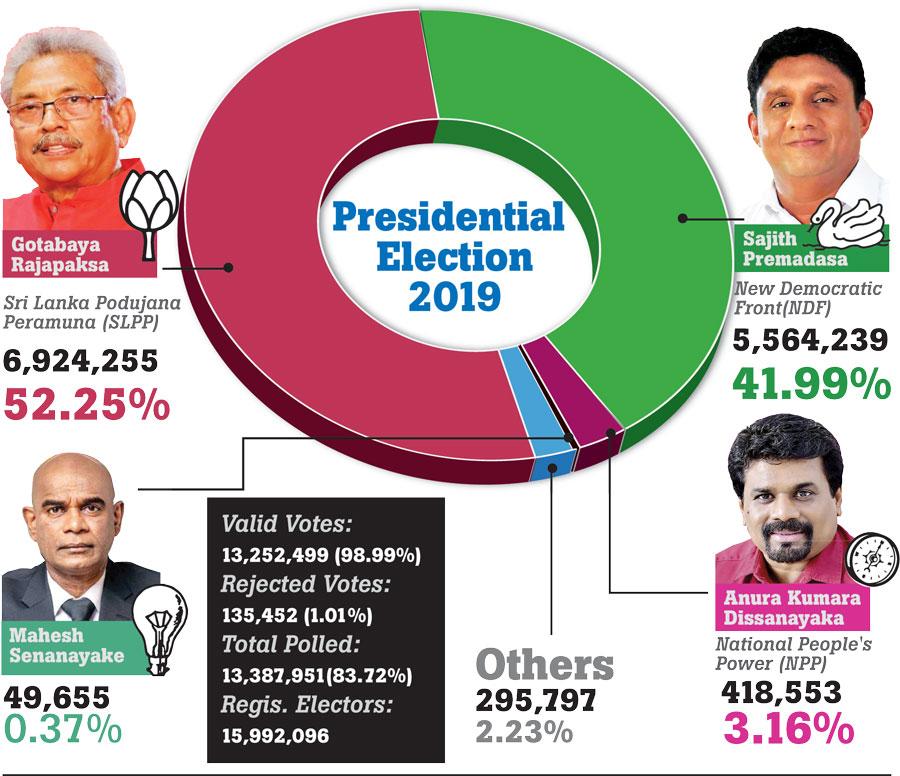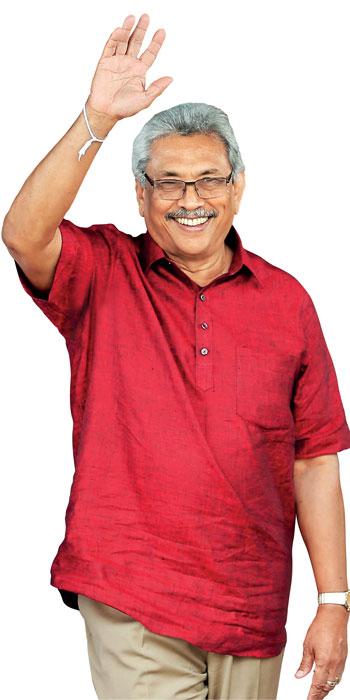18 Nov 2019 - {{hitsCtrl.values.hits}}

Records a majority of 1.3 million votes
Wins in 16 districts
By Sandun A. Jayasekera 
Voters in Sri Lanka gave a clear mandate to Nandasena Gotabaya Rajapaksa to guide the destinies of Sri Lanka in the next five years by electing him as the 7th Executive President with a majority of 1,360,011 votes over his closest rival Sajith Premadasa at Saturday’s Presidential Poll.
President elect Rajapaksa has polled 6,924,255 (52.25%) votes while Deputy Leader of the UNP and Minister Premadasa was able to garner only 5,564,239
(41.99%) votes.
Anura Kumara Dissanayaka of the NPP at a distanced third has received 418,553 (3.16%) votes contesting under the Compass symbol. All other 32 candidates were able to scrape through only with 345,452 votes (2.6%). A total of 15,992,096 electors had been eligible to vote on
Saturday’s election.
Mr Rajapaksa contested under the Pohottuwa symbol of the Sri Lanka Pudujana Peramuna (SLPP) that represented mainly the Sinnhala Budhist vote base and the traditional left. Though the Presidential election 2019 will go in the history as an extremely free and fair election without a single election related violence of serious nature reported, it will also be recorded as an election that clearly divided the Sinhala speaking voters with Sinhala Buddhist voters with voters in the North-East supporting Mr Premadasa overwhelmingly while Mr Rajapaksa taking a big lead in the South, West, Central, Sabaragamuwa, North-Central, Wayamba and Uva provinces.
Mr Premadasa was backed by a rainbow coalition of political parties led by the UNP and including Tamil and Muslim political parties like the TNA, the SLMC and All Ceylon Makkal Congress and a section of the CWC and Upcountry Peoples Front and Sinhala Buddhist minority parties like Sihala Urumaya.
The significance of Saturday’s election was the huge support enjoyed by Mr Rajapaksa among Sinhala Buddhist voters in almost all districts except a few from Anuradhapura to Hambantota and from Monaragala to Puttalam that had been the deciding factor for the clear victory of him.
Mr Rajapaksa has drawn big majorities in the constituencies where Sinhala Buddhists are dominated while Mr Premadasa has won handsomely at all constituencies and districts where Tamil and Muslim voters are the majority.
The 37 day election campaign concluded on last Wednesday and nominations were accepted on October 7. Postal voting was held on October 31, November 01, 04 and 5 and again on November 07.
At a casual glance at the districts won by two candidates proves this phenomena whereas President elect Rajapaksa securing victory at the districts of Colombo, Kandy, Puttalam, Polonnaruwa, Badulla, Gampaha, Ratnapura, Galle, Matara, Hambantota, Kalutara, Kegalle, Kurunegala and Matale with
big majorities.
Mr Premadasa has won the districts of Jaffna, Vanni, Mullaithivu, Trincomalee, Mannar, Kalkudah and Digamadulla with a huge majority.
A total of 13,387,951 registered voters had used their franchise at this election. Though the turnout at the poll was extremely satisfactory at 83.72%, the number of rejected votes at 135,452 (1.01%) was a setback to the conduct of elections in Sri Lanka where free franchise is enjoyed since 1931 and the literacy rate is over 98%.
Over 20,000 local observers and 200 foreign observers monitored the election and their final report is expected today.
19 Nov 2024 7 hours ago
19 Nov 2024 7 hours ago
19 Nov 2024 9 hours ago
19 Nov 2024 19 Nov 2024
19 Nov 2024 19 Nov 2024